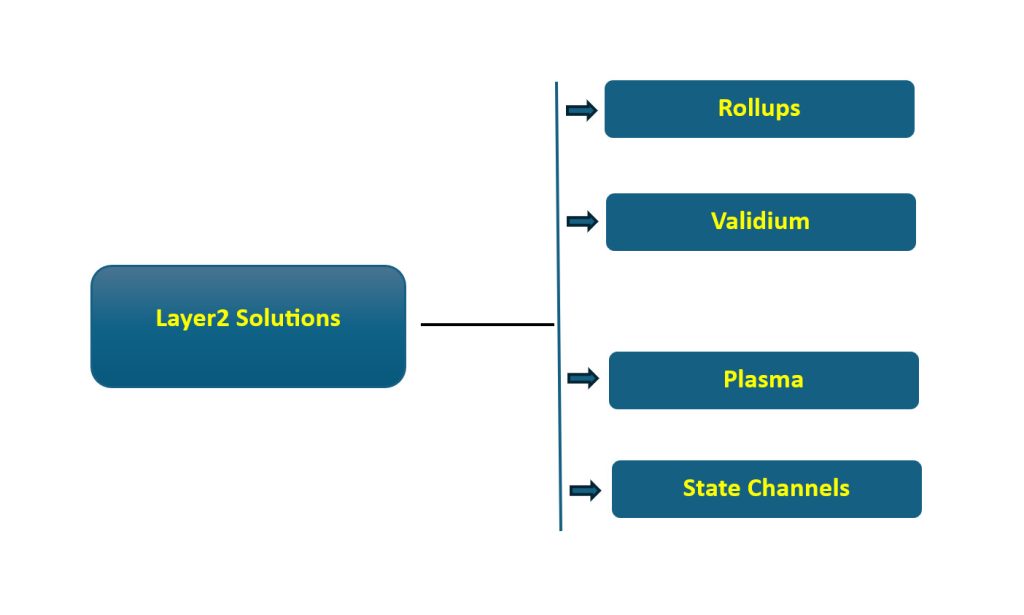Introduction
Although Ethereum is the most widely used blockchain for decentralized applications (dApps), it has long grappled with scalability and high gas fees. Developed as a solution to these problems, Layer2 networks aim to enable faster and lower-cost transactions without compromising Ethereum’s security.
The Basics of Layer2 Technology
Ethereum Layer2 networks are solutions that run on top of the Ethereum chain (Layer1) and inherit its security model to provide faster and scalable transaction processing. Layer2 scalability solutions process transactions in their own environment and then batch send the results of those transactions to L1. This reduces Ethereum’s congestion and significantly lowers transaction fees.
Layer2 solutions can generally be categorized into four main categories:
Rollups
Rollups process transactions off-chain the Ethereum network, sending a summary of transactions (state root) to the main chain. There are two main types:
- Optimistic Rollup: Processes transactions outside the main blockchain and sends back their summaries. Transactions are considered correct by default unless proven otherwise. If a user detects a fraudulent transaction, they can challenge it within a certain “challenge” period. Arbitrum, Base and Optimism can be included in this category.
- ZK-Rollup (Zero-Knowledge Rollup): Cryptographic proofs known as ZK proofs are used. The validity of each transaction is sent along with mathematical proofs. This approach is much more secure than optimistic rollups. It also offers faster termination time. StarkNet and zkSync Era are examples of this type.
Validium
Validiums use ZK proofs but write transaction data to off-chain media, not L1. While this provides higher throughput, there are some risks in terms of data availability.
Plasma
Plasma solutions process transactions in sidechains and send only state roots to the main chain. However, they have lost their popularity due to the speed of development and lack of user-friendliness.
State Channels
State Channels work as bidirectional payment or interaction channels between participants. They transmit the certainty of the transaction to the main chain using contracts with a multisig structure to enable participants to transact quickly and conveniently off-chain. This minimizes transaction fees and delays due to network congestion.
Development of Ethereum L2 Networks
Ethereum’s move towards L2 solutions gained momentum in 2020 as a result of developments in DeFi (Decentralized Finance) and record transaction fees on the network. Especially with the intensification of NFT and gaming applications, the Ethereum network came to the point of deadlock many times.
These troubling processes accelerated the development of L2 solutions. Thus, projects that each offer different solutions started to be developed. Some of the main projects are presented below as examples.
- Optimism was launched on the mainnet in 2021 as one of the first large-scale L2 solutions.
- Arbitrum attracted a lot of attention with its Arbitrum One network launched towards the end of 2021.
- zkSync was one of the first projects to commercialize ZK-Rollup technology.
- StarkNet offered a different approach with STARK, the proprietary cryptographic proof-of-stake technology developed by StarkWare.
- Base was developed by Coinbase in 2023 and became prominent as an L2 network using the Optimism infrastructure. The Base network aims to bridge the gap between Web2 and Web3 users and accelerate mass adoption.
Current L2 Projects and Their Position in the Market
Ethereum Layer-2 projects are one of the fastest growing areas of the cryptocurrency industry by 2025. Leading L2 networks such as Arbitrum, Optimism, Base, StarkNet and zkSync hold billions of dollars in assets and host hundreds of decentralized applications.
| Demand Factor | Description |
|---|---|
| Corporate demand | Custody collaborations with actors like BNY Mellon |
| Compliance with legal regulations | Compliance with US and global legal standards |
| Integration with RippleNet | Potential for systematic use with XRP |
| Compatibility with the Ethereum network | Wide user base with DeFi protocols |
| Providing liquidity | Efficient use of XRP with stablecoin via ODL |
Economic Impact and Future of L2s
Layer-2 solutions make significant contributions to the Ethereum ecosystem, not only technically but also in terms of cost.
In particular;
• Reduced gas costs have allowed small investors to re-engage in the DeFi and NFT space.
• Faster and lower-cost transactions have improved the user experience of DeFi protocols.
• New tokenomics: Governance tokens such as ARB and OP have incentivized users and enabled DAO structures.
Potential Risks can be listed as follows;
• Centralization: In some L2 networks, transaction sequencers are managed by a single or limited number of organizations.
• Data availability: As data is kept off-chain in some solutions, users may not be able to access their assets in the event of a network crash.
• Compatibility issues: For some L2s that are not compatible with EVM, the development process becomes more complex.
Conclusion
Ethereum Layer2 technologies have transformed the network’s transaction capacity and improved the user experience without sacrificing decentralization. Rollup-based solutions have not only solved the scalability issues facing Ethereum, but have also brought many different and diverse applications to the ecosystem.
Moreover, Layer2 projects contribute to the network by providing innovative structures not only in terms of technical but also economic and governance models. Integrating L2 tokens (such as ARB, OP) into governance processes allows users to become ecosystem participants, not just spectators. In addition, the application layers built on top of L2s themselves reflect Ethereum’s evolution to become not only an infrastructure but also a multi-chain ecosystem.
There are some risks to be aware of at this point. Centralized sequencer structures, data availability issues are among the important issues that still need to be resolved for the long-term sustainability of these projects. Ethereum’s successful management of this process will be possible with infrastructure updates at both L1 and L2 levels. In particular, the implementation of development proposals such as EIP-4844 (Proto-Danksharding) will further reduce the transaction costs of rollups and contribute to their widespread adoption.
In conclusion, Ethereum Layer2 solutions are not just a temporary scalability patch; they have become a structural layer that will play a central role in the future of the ecosystem. In the coming years, these solutions are expected to play a key role in realizing the Web3 vision with increased enterprise adoption, more advanced governance models and user-friendly interfaces.
Disclaimer
This content is for educational purposes only and does not constitute investment advice. Please conduct your own research before making financial decisions.






